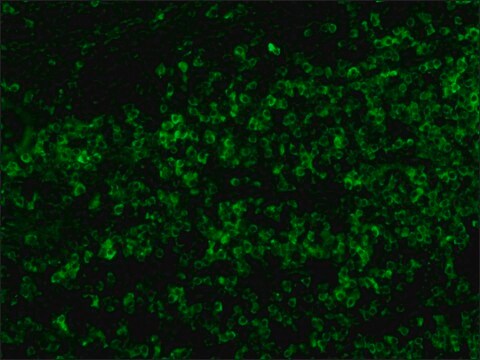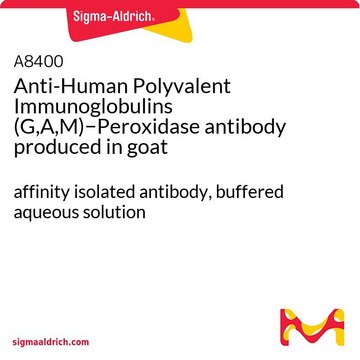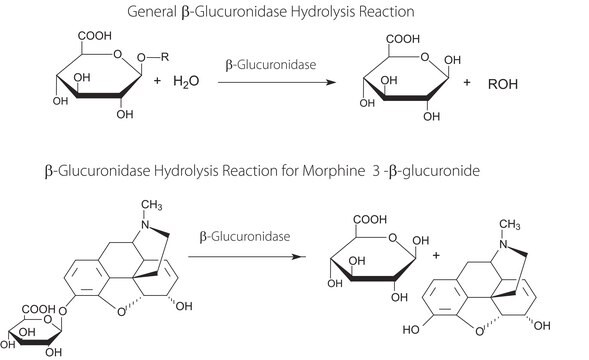I1761
Anti-Human Polyvalent Immunoglobulins (G,A,M) antibody produced in goat
whole antiserum
Sign Into View Organizational & Contract Pricing
All Photos(1)
About This Item
Recommended Products
biological source
goat
Quality Level
conjugate
unconjugated
antibody form
whole antiserum
antibody product type
secondary antibodies
clone
polyclonal
contains
15 mM sodium azide
technique(s)
immunoelectrophoresis: suitable
shipped in
dry ice
storage temp.
−20°C
target post-translational modification
unmodified
Looking for similar products? Visit Product Comparison Guide
General description
Immunoglobulin G (IgG) belongs to the immunoglobulin family and is a widely expressed serum antibody. IgG is usually found as a monomer. IgG antibody subtype is the most abundant of serum immunoglobulins of the immune system. About 70 percent of the total immunoglobulin consists of IgG. Immunoglobulin M (IgM ) is a high molecular weight protein that has five or six subunits. Human serum shows low concentration of IgM monomers. It has a high carbohydrate content of about 12%. It is the first immunoglobulin produced by neonates.
Specificity
The antiserum is determined to be immunospecific for human IgG, IgA and IgM. Reactivity is also observed against light chains.
Application
Anti-Human Polyvalent Immunoglobulins (G,A,M) antibody produced in goat has been used in immunoassays/sandwich immunoassay and enzyme-linked immunosorbent assay (ELISA).
Biochem/physiol Actions
IgG antibody subtype is the most abundant of serum immunoglobulins of the immune system. It is secreted by B cells and is found in blood and extracellular fluids and provides protection from infections caused by bacteria, fungi and viruses. Maternal IgG is transferred to fetus through the placenta that is vital for immune defence of the neonate against infections. IgA antibody is secretory antibody and is present abundantly in mucous linings of gastrointestinal, respiratory and genitourinary tracts, tears and saliva. IgM antibodies are present as pentamers in the serum and are produced in response to antigens.
Immunoglobulin G (IgG) participates in hypersensitivity type II and type III. Immunoglobulin M (IgM) acts as an antigen specific part of the B cell antigen receptor on the surface of B lymphocytes that are not stimulated, in its monomeric form. Polymeric IgM molecules also serve as important activators of the classical complement cascade. IgM is essential in agglutination and cytolytic reactions.
Physical form
The antibody is supplied as a liquid containing 0.1% sodium azide.
Storage and Stability
For continuous use, store at 2-8 °C for up to one month. For extended storage, the solution may be frozen in working aliquots. Repeated freezing and thawing is not recommended. Storage in "frost-free" freezers not recommended. If slight turbidity occurs upon prolonged storage, clarify the solution by centrifugation before use.
Not finding the right product?
Try our Product Selector Tool.
Storage Class Code
10 - Combustible liquids
WGK
WGK 3
Flash Point(F)
Not applicable
Flash Point(C)
Not applicable
Personal Protective Equipment
dust mask type N95 (US), Eyeshields, Gloves
Choose from one of the most recent versions:
Already Own This Product?
Find documentation for the products that you have recently purchased in the Document Library.
High level transient production of recombinant antibodies and antibody fusion proteins in HEK293 cells
Jager V, et al.
BMC biotechnology, 13(1), 52-52 (2013)
The Immunoglobulins: Structure and Function (1998)
Molecular Genetics of Immunoglobulin, 17 (1987)
Volker Jäger et al.
BMC biotechnology, 13, 52-52 (2013-06-28)
The demand of monospecific high affinity binding reagents, particularly monoclonal antibodies, has been steadily increasing over the last years. Enhanced throughput of antibody generation has been addressed by optimizing in vitro selection using phage display which moved the major bottleneck
Douglas B Weibel et al.
Analytical chemistry, 77(15), 4726-4733 (2005-08-02)
This paper describes torque-actuated valves for controlling the flow of fluids in microfluidic channels. The valves consist of small machine screws (> or =500 microm) embedded in a layer of polyurethane cast above microfluidic channels fabricated in poly(dimethylsiloxane) (PDMS). The
Our team of scientists has experience in all areas of research including Life Science, Material Science, Chemical Synthesis, Chromatography, Analytical and many others.
Contact Technical Service








